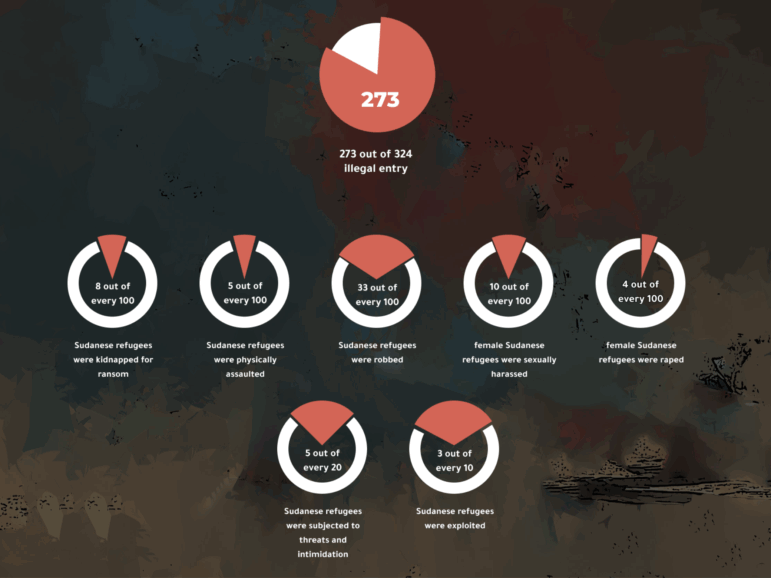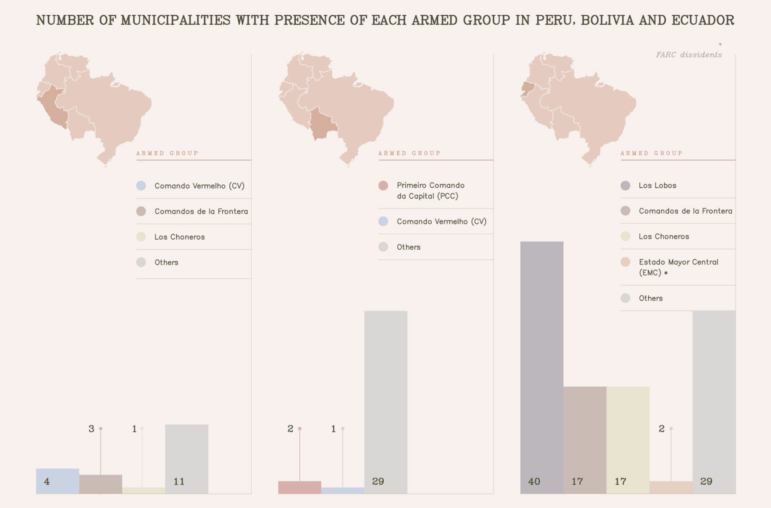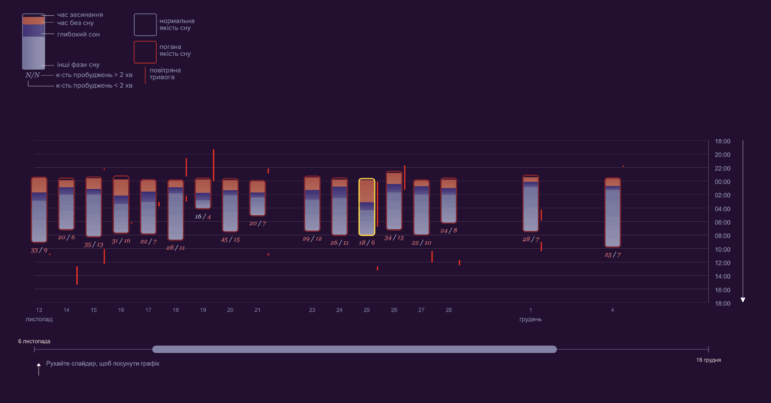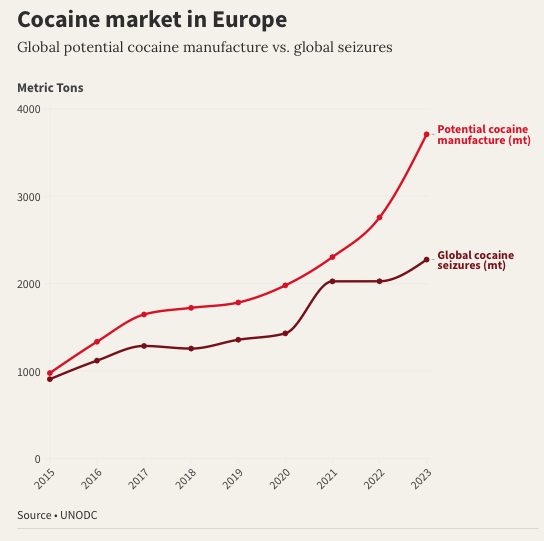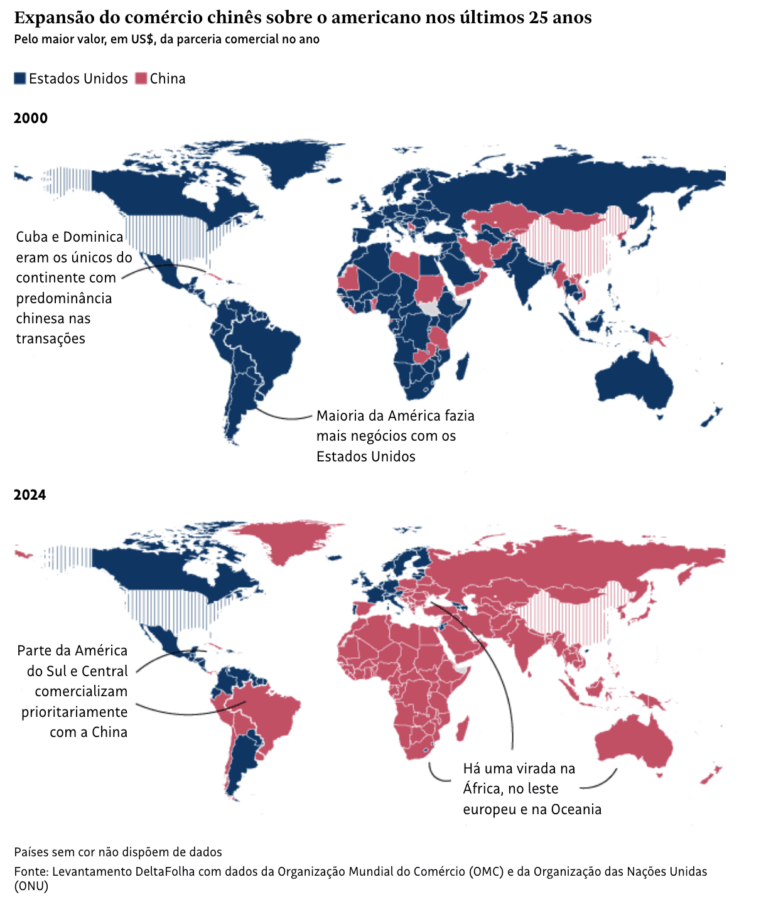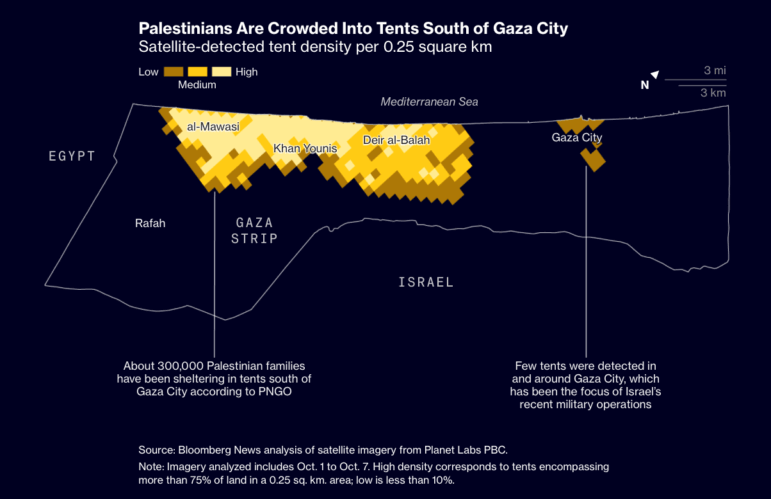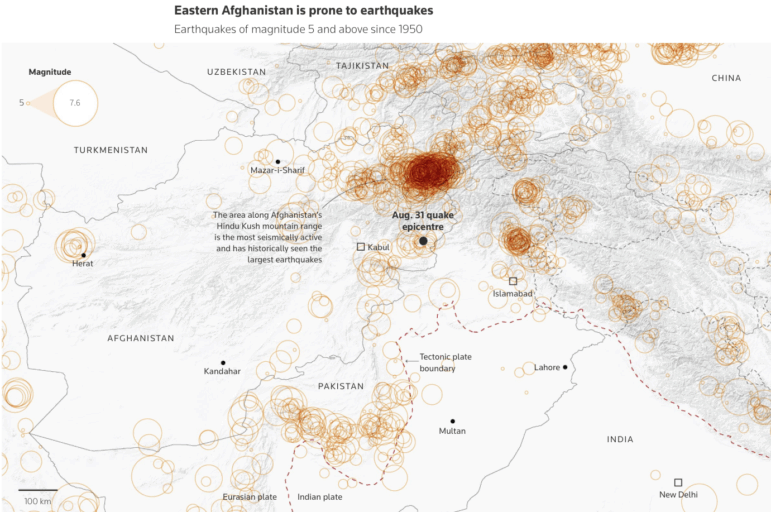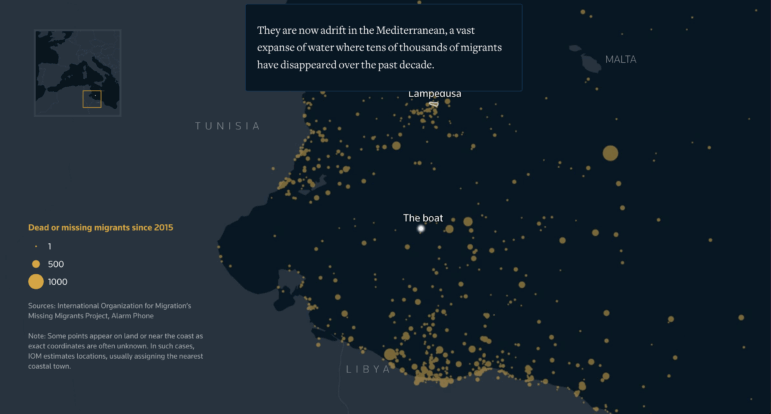Image: Screenshot, Reuters
US Military’s Caribbean Buildup, Hurricane Melissa’s Devastating Impact, Exploitation of Sudanese Refugees, Europe’s Cocaine Glut
Reuters pulled together numerous data sources to track the accelerated military buildup the US government has undertaken recently in the Caribbean, reopening shuttered or defunct bases while engaging in deadly strikes on alleged drug smuggling boats said to originating from Venezuela. In this edition of our Data Journalism Top 10, covering stories from October 21 to November 4, we also feature Bloomberg’s satellite analysis of the destruction left by the strongest hurricane to hit Jamaica in modern times, ARIJ’s compelling account of the abuses suffered by Sudanese refugees fleeing into Egypt, OCCRP on how drug traffickers in Europe have turned to burying their product to manage a market glut, and Decoherence Media’s look into the archives of a defunct neo-Nazi online forum to map its former members.
Is the US Preparing for Military Action Against Venezuela?
Since September, the US has conducted a series of strikes on alleged drug-trafficking vessels in the Caribbean and Pacific Ocean, killing more than 60 people. This operation is being framed by the Trump administration as an effort to curb cartels and the flow of drugs into the US. A Reuters visual investigation revealed and tracked the scale of the buildup of military assets, some of which are stationed right off the coast of Venezuela. In the past two months, reporters photographed US military bases, analyzed satellite imagery, and used ship and flight-tracking data to visualize the expanding activity across the Caribbean. Using open source visuals and on-the-ground reporting, the team also traced US military vessel movements. The investigation identified construction activity at key US bases, including the previously shuttered Roosevelt Roads base in Puerto Rico. After speaking to US military officials and maritime experts, the report concluded that Washington’s buildup seems poised to extend beyond mere counter-narcotics operations.
The Scale of Destruction from Hurricane Melissa
Hurricane Melissa was the worst storm to hit Jamaica in recorded history. The Category 5 hurricane killed more than 40 people on the island, and crippled essential services. In the hard-hit southwestern town of Black River, Bloomberg reporters used high-resolution synthetic aperture radar data from UMBRA to assess the extent of damage. The analysis showed that 76% of buildings were damaged, many with collapsed roofs. Additional reporting drew on Copernicus Sentinel-1 satellite data to estimate damage across developed areas, revealing that western towns suffered the most severe losses. Bloomberg also used NASA’s Black Marble night-light imagery to measure the storm’s impact on the power grid, which “sustained massive damage.” Some 70% of transmission lines failed, leaving residents across the island country without power.
Exploitation of Sudanese Refugees Fleeing War
This joint investigation by ARIJ and Al Mohajer revealed how smugglers and criminal gangs are preying on refugees fleeing the violence in Sudan. Focusing their investigation on refugees that have crossed into neighboring Egypt, reporters found widespread problems but also that those who lacked UNHCR registration were unable to file police reports against their abusers. The team interviewed a dozen survivors of smuggler-related violence and surveyed 324 refugees, finding a number of men and women had been raped or sexually harassed. One-third of refugees had been robbed, one in 12 kidnapped for ransom, and others threatened or financially exploited. Through interviews, the journalists mapped four main smuggling routes in an interactive visualization showing border stops leading to a quarry region near Aswan, a city in southern Egypt that is notoriously dangerous.
Elsewhere, a joint investigation by Sky News, Sudan War Monitor, and Lighthouse Reports used open source reporting to trace the fate of civilians who fled a key Sudanese frontline city, and exposed how paramilitaries hunted them down in surrounding “killing fields.”
Investigating the Archive of a Neo-Nazi Online Forum
Decoherence Media is an outlet co-founded by former Bellingcat data scientist Tristan Lee that investigates authoritarian and anti-democratic movements. In this, the first of a three-part investigation, the team revisited a 2019 leak of a database from the neo-Nazi online forum Iron March. Researchers located an original torrent file containing the full web server for the forum, which was promoted as “the first and only global Online Fascist Zine.” The server contained “a bounty of information,” including email correspondence, visitor logs with IP addresses, draft posts, and user comments, allowing investigators to map the network’s structure and reach. Using IP-based geolocation, they traced more than 275,000 unique visitors, including known members of the militant Atomwaffen Division, with most traffic coming from the US, Canada, Europe, and Australia. Though the Iron March forum itself is now defunct, its legacy endures through decentralized channels and a public database, now searchable via fashyleaks.com, which journalists, researchers and activists can query.
Mapping Crime Gangs in the Amazon
To investigate the reach of armed and criminal groups across the Amazon, researchers from Amazon Underworld mapped 987 municipalities in Bolivia, Brazil, Colombia, Ecuador, Peru, and Venezuela, documenting where such networks operated. Through field interviews, document analysis, and information requests, the team gathered qualitative data that revealed 67% of municipalities face at least one armed or criminal group, and 32% face multiple actors, including a number of gangs that operate across borders. In many areas, illicit economies have become the dominant source of income, with profits surpassing the resources of state agencies used to combat these groups. The findings were visualized in an interactive map showing how organized crime impacts key Amazonian territories.
How California’s Wildfire Prevention Blackouts Impact Vulnerable People
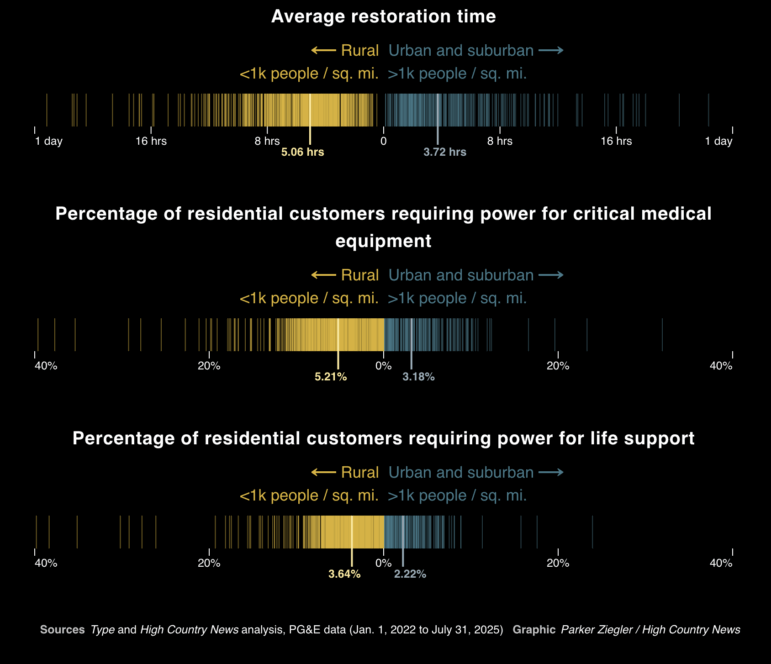
Image: Screenshot, High Country News
After a catastrophic wildfire sparked by a damaged transmission tower, state regulators in California introduced new wildfire prevention rules. One of the fixes deployed by the state’s largest utility company — PG&E — saw a change to the fast-trip settings that automatically cut electricity when equipment detects a potential physical hazard that might spark a fire. Reporters from High Country News and Type Investigations conducted a first-of-its-kind analysis using data from Cal Fire and PG&E to map service areas and circuit lines against wildfire locations while tracking cumulative power outages from 2022 to 2025. Their findings show that rural communities, which often border forests and face higher fire risk, experienced 600% more fast-trip outages than urban areas. For millions of Californians, these outages have become routine: nearly one million people experienced outages in 2024, with power repeatedly cut to homes and businesses. Reporters estimated that more than 20,000 people who rely on electricity for their medical devices are PG&E customers that live in rural areas averaging 10 or more outages each year.
War and Insomnia in Ukraine
Journalists and information designers at Texty visualized findings from a scientific study on sleep patterns in Ukraine to find out the impact of war on the citizenry’s rest. They tracked more than 100 people who kept sleep diaries to capture sleep phases. Texty transformed this data into smart interactive graphics that broke each night of sleep into stages of light sleep, deep sleep, REM, and awake time, showing how shelling and air-raid alarms repeatedly disturbed rest. The project analyzed 40 nights of data collected between October 2023 and March 2024, comparing sleep patterns to the frequency of air raid alerts. Even as shelling lessened, chronic sleep disruption persisted: 44% of participants showed signs of insomnia and 27% had clinical insomnia, nearly triple the rates found in countries at peace. Also worth reading this week related to the conflict in Ukraine, is Der Spiegel’s report on the numbers of Russian soldiers who have died in the war in Ukraine.
European Drug Gangs Burying Cocaine
Last year, a Spanish police raid uncovered seven metric tons of cocaine buried on a farm near Seville — a haul with a street of value of €420 million (US$485 million). A report by the Organized Crime and Corruption Reporting Project (OCCRP) suggests that this is part of a new strategy, and that traffickers are increasingly hoarding or burying cocaine to manage a market flooded with supply. It also outlined how high-yield coca crops, and increasingly inventive smuggling methods — from ‘narco-subs’ to ‘chemical camouflage’ — have reshaped the global cocaine trade. Drawing on data from the UN Office on Drugs and Crime (UNODC), the European Union Drugs Agency, and interviews with experts across Europe and Latin America, reporters found that coca cultivation in Colombia grew by nearly two-thirds between 2018 and 2023. With wholesale prices plunging, and even dropping by half in some markets, traffickers are hiding shipments to manipulate prices.
Tracking Rhetorical Concerns for US Democracy in History
For The Pudding, data journalist and journalism professor Alvin Chang analyzed how often the word “democracy” appeared, and when it was perceived as under threat, in the Congressional Record, the official transcript of everything said in the US Congress, combining historical records from 1873 to 2017 with recent congressional speeches. Using a Google language model, Chang examined the 200 words before and after each mention of “democracy” to determine whether the context described a threat. He classified these as: general threats to the democratic system, external threats from abroad, internal threats from government actors, or systemic and legal issues that undermine democracy. As users scroll through the piece, speeches from each era unfold, with dots representing mentions that merge into a bar chart showing how often the word appeared. The visualization charts a shifting narrative, as fears of democracy’s collapse moved from foreign enemies during world wars to threats said to be emerging from the government itself in recent years.
China’s Trade Hegemony
Folha de S.Paulo mapped one of the most significant shifts in modern geopolitics — the rise of China as a rival of the United States in world trade. Using UN data on trade in goods between 2000-2024 and WTO data on services between 2005-2023, reporters compared the total trade of the US and China with other countries around the world. In 2006, 148 nations traded more with the US than with China, they found, but by 2024, the situation had flipped: 141 countries traded more with China and only 82 favored the US. Interactive maps illustrated the global shift, showing China’s expansion first across Oceania, Africa, and Eastern Europe, and later into Western Europe and Latin America. The analysis linked this dominance to decades of economic liberalization, China’s entry into the WTO in 2001, and large-scale industrial growth driven by infrastructure projects like the Belt and Road Initiative.
Bonus Item: End of Coal in Spain
Spain shut its unprofitable coal mines by the end of 2018 and has largely phased out coal-fired power generation over the past decade, promising a just transition for mining regions. Datadista’s investigation drew on figures from Spain’s Institution for Just Transition and energy-sector data, and reporters charted how mining employment fell from 45,000 in 1990 to just 1,700 by early 2018. Between 2020 and 2021, the government signed Just Transition Agreements with unions and utilities to guarantee early retirement, retraining, and relocation for workers. Yet new industrial projects in towns like As Pontes and Andorra often stalled or lacked binding guarantees. Funded by €868 million (US$1 billion) from the EU’s Just Transition Fund and €300 million (US$330 million) in recovery funds, many initiatives focused on small local projects or municipal infrastructure. Datadista found that despite the plants’ closures, the promised economic renewal lagged behind, leaving mining communities uncertain about their future.
Hanna Duggal is a data journalist at AJ Labs, the data, visual storytelling, and experiments team of Al Jazeera and a GIJN contributor. She has reported on issues such as policing, surveillance, and protests using data, and reported for GIJN on data journalism in the Middle East, investigating algorithms onTikTok, and on using data to investigate tribal lands in the US.






